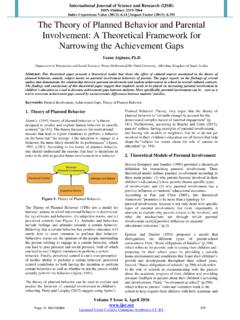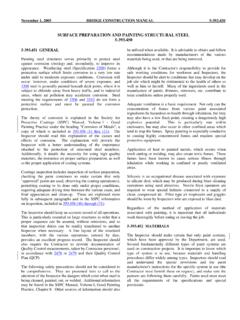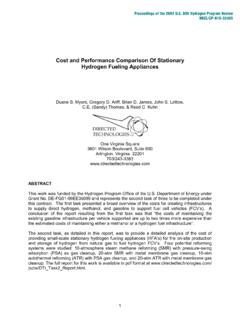Transcription of Impact of Solid Waste on Health and the Environment - IJSR
1 International Journal of Science and Research (IJSR). ISSN (Online): 2319-7064. Index Copernicus Value (2013): | Impact Factor (2013): Impact of Solid Waste on Health and the Environment Swati Srivastava 1, Ritu Singhvi2. 1. Research Scholar, Department of Family Resource Management, , Udaipur, India 2. Professor, Department of Family Resource Management, , Udaipur, India Abstract: Modernization and progress has had its share of disadvantages and one of the main aspects of concern is the pollution it is causing to the earth be it land, air, and water. With increase in the global population and the rising demand for food and other essentials, there has been a rise in the amount of Waste being generated daily by each household. Waste that is not properly managed, especially excreta and other liquid and Solid Waste from households and the community, are a serious Health hazard and lead to the spread of infectious diseases.
2 Thus excessive Solid Waste that is generated should be controlled by taking certain preventive measures. Keyword: Pollution, population, household, hazard, Solid Waste , community. 1. Introduction Solid Waste can be classified into different types, depending on their source; household Waste is generally classified as municipal Waste ; industrial Waste as hazardous Waste , and biomedical Waste or hospital Waste as infectious Waste . The term '' Solid Waste '' means any garbage, refuse, or sludge from a Waste treatment plant, water supply treatment plant, or air pollution control facility and other discarded material, including Solid , liquid, semisolid, or contained gaseous material resulting from industrial, commercial, mining, and agricultural operations (US Law- Solid Waste Act 2, 1999). The term ''disposal'' means the discharge, deposit, injection, dumping, spilling, leaking, or placing of any Solid Waste or hazardous Waste into or on any land or water so that such Solid wastes, hazardous wastes, or any constituent thereof may enter the Environment or be emitted into the air or discharged into any waters, including ground waters, from community activities (US Law- Solid Waste Act 2, 1999).
3 Figure: Percentage distribution of various Solid Waste Waste that is not properly managed, especially excreta and management other liquid and Solid Waste from households and the community, are a serious Health hazard and lead to the Solid Waste disposal sites are found on the outskirts of the spread of infectious diseases. Unattended Waste lying around urban areas, turning into the child sources of contamination attracts flies, rats, and other creatures that in turn spread due to the incubation and proliferation of flies, mosquitoes, disease. Normally it is the wet Waste that decomposes and and rodents; that, in turn, are disease transmitters that affect releases a bad odour. This leads to unhygienic conditions population's Health , which has its organic defences in a and thereby to a rise in the Health problems. The plague formative and creative state. The said situation produces outbreak in Surat is a good example of a city suffering due gastrointestinal, dermatological, respiratory, genetic, and to the callous attitude of the local body in maintaining several other kind of infectious diseases.
4 Consequently, cleanliness in the city. Plastic Waste is another cause for ill dumping sites have a very high economic and social cost in Health . Thus excessive Solid Waste that is generated should the public Health services, and have not yet been estimated be controlled by taking certain preventive measures. by governments, industries, and families. The group at risk from the unscientific disposal of Solid Waste include the population in areas where there is no proper Waste disposal method, especially the pre-school children; Waste workers;. and workers in facilities producing toxic, and infectious material. Other high-risk groups include the population living close to a Waste dump and those whose water supply has become contaminated, either due to Waste dumping or leakage from landfill sites. Uncollected Solid Waste also increases risk of injury and infection. Volume 4 Issue 9, September 2015. Paper ID: SUB158535 1770.
5 Licensed Under Creative Commons Attribution CC BY. International Journal of Science and Research (IJSR). ISSN (Online): 2319-7064. Index Copernicus Value (2013): | Impact Factor (2013): 2. Characteristics of Solid Wastes 5. Sanitary Landfill Corrosive: these are wastes that include acids or bases Land disposal is the most common management strategy for that are capable of corroding mental containers, tanks municipal Solid Waste . Refuse can be safely deposited in a (Moeller,2005). sanitary landfill, a disposal site that is carefully selected, Ignitability: this is Waste that can create fires under designed, constructed, and operated to protect the certain condition, Waste oils and solvent Environment and public Health . One of the most important Reactive: these are unstable in nature, they cause factors relating to landfilling is that the buried Waste never explosions, toxic fumes when heated. comes in contact with surface water or groundwater.
6 Toxicity: Waste which are harmful or fatal when ingested Engineering design requirements include a minimum or absorbed. distance between the bottom of the landfill and the Solid - Waste treatment and disposal seasonally high groundwater table. Most new landfills are Once collected, municipal Solid Waste may be treated in required to have an impermeable liner or barrier at the order to reduce the total volume and weight of material that bottom, as well as a system of groundwater-monitoring requires final disposal. Treatment changes the form of the wells. Completed landfill sections must be capped with an Waste and makes it easier to handle. It can also serve to impermeable cover to keep precipitation or surface runoff recover certain materials, as well as heat energy, for away from the buried Waste . recycling or reuse. 6. Landfill 3. Incineration Disposal of Waste in a landfill involves burying the Waste Incineration is a Waste treatment process that involves the and this remains a common practice in most countries.
7 Combustion of organic substances contained in Waste Landfills were often established in abandoned or materials (Knox, 2005). Incineration and other high- unused quarries, mining voids or borrow pits. A properly temperature Waste treatment systems are described as designed and well-managed landfill can be a hygienic and "thermal treatment". Incineration of Waste materials converts relatively inexpensive method of disposing of Waste the Waste into ash, flue gas, and heat . The ash is mostly materials. Older, poorly designed or poorly managed formed by the inorganic constituents of the Waste , and may landfills and open dumps can create a number of adverse take the form of Solid lumps or particulates carried by the environmental impacts such as wind-blown litter, attraction flue gas. The flue gases must be cleaned of gaseous and of vermin, and generation of liquid leachate. Another particulate pollutants before they are dispersed into common product of landfills is gas (mostly composed the atmosphere.)
8 In some cases, the heat generated by of methane and carbon dioxide), which is produced incineration can be used to generate electric power. from anaerobic breakdown of organic Waste . This gas can Incinerators reduce the Solid mass of the original Waste by create odor problems, kill surface vegetation and is 80 85% and the volume (already compressed somewhat a greenhouse gas. ingarbage trucks) by 95 96%, depending on composition and degree of recovery of materials such as metals from the Design characteristics of a modern landfill include methods ash for recycling. to contain leachate such as clay or plastic lining material. Deposited Waste is normally compacted to increase its 4. Composting density and stability and covered to prevent attracting vermin (such as mice or rats). Many landfills also have landfill gas extraction systems installed to extract Organic matter constitutes 35% 40% of the municipal Solid the landfill gas.
9 Gas is pumped out of the landfill using Waste generated in India. This Waste can be recycled by the perforated pipes and flared off or burnt in a gas engine to method of composting, one of the oldest forms of disposal. It generate electricity. is the natural process of decomposition of organic Waste that yields manure or compost, which is very rich in nutrients. Composting is a biological process in which micro- 7. Recycling organisms, mainly fungi and bacteria, convert degradable organic Waste into humus like substance. This finished Recycling is a resource recovery practice that refers to the product, which looks like soil, is high in carbon and nitrogen collection and reuse of Waste materials such as empty and is an excellent medium for growing plant. beverage containers. The materials from which the items are made can be reprocessed into new products. Material for Composting: some benefits recycling may be collected separately from general Waste Compost allows the soil to retain more plant nutrients using dedicated bins and collection vehicles, a procedure over a longer period.
10 Called kerbside collection. In some communities, the owner It supplies part of the 16 essential elements needed by the of the Waste is required to separate the materials into various plants. different bins ( for paper, plastics, metals) prior to its It helps reduce the adverse effects of excessive alkalinity, acidity, or the excessive use of chemical fertilizer. collection. The recycling of complex products (such as It makes soil easier to cultivate. computers and electronic equipment) is more difficult, due It helps keep the soil cool in summer and warm in winter. to the additional dismantling and separation required. It aids in preventing soil erosion by keeping the soil covered. It helps in controlling the growth of weeds in the garden. Volume 4 Issue 9, September 2015. Paper ID: SUB158535 1771. Licensed Under Creative Commons Attribution CC BY. International Journal of Science and Research (IJSR). ISSN (Online): 2319-7064.













